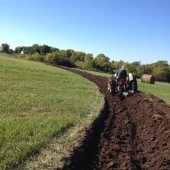Dan Grubbs wrote:If you look at the swale/berm I cut yesterday on our farm, you'll see about a 300-foot swale that is about 18 inches deep, four feet wide and a burm of about two feet in height. Today I covered the berm with a thick coat of hay to keep the rain from washing it away before I get things planted on it. So, obviously, I'm asking for planting suggestions. I will be ordering a variety of nut trees to plant, too.
I want both food and soil regeneration on our farm. On either side of the swale/berm is pasture and open for most anything, but likely will grow various forage for our goats next year. We live in Northwest Missouri in the upper part of hardiness Zone 6a. What would you all suggest?
Hey Dan, I haven't read most of this thread, But great work using that equipment for your swale install and thanks for the pics. I'm sure you've planted some things by now since this post is about 2 years old now. However, here are some plant suggestions for establishing a productive poly-cultural food forest.
The first few plant species are more productive, and complex carbon organisms (meaning they take long to establish and produce well). Underneath, divided by the dotted line, are support species (they grow much quicker, fix nitrogen & other elements, and produce biomass for the soil organisms), some of which are productive as well.
Even if you have planted this swale, hopefully this list helps you to establish more and diversify the ones already growing. Let me know what you think.
p.s. I tried attaching a text document to no avail, so i apologize for the sloppy copy/paste format
Plant List
Name Latin Type Hardiness
Chestnut(Chinese) Castanea mollissima D. Tree 4-8
“ “(Badgersett) Castanea sativa “ 4-9
Walnut(Black) Juglans nigra “ 4-8
“ “(English) Juglans regia “ 4-9
Mulberry(red) Morus rubra “ 5-9
Apple(Various) Malus pumila “ 3-8
Pear(Various) Pyrus communis “ 4-8
Cherry(Various) Prunus serotina “ 3-9
Plum(Various) Prunus americana “ 3-8
Pawpaw Asimina trilobagaria “ 5-9
Hazelnut(Am.) Corylus americana D. Shrub 3-9
“ “(beaked) Corylus cornuta “ 3-8
Elderberry(Am.) Sambucus canadensis “ 3-10
Quince Cydonia oblonga “ 5-9
Goumi Elaeagnus multiflora “ 4-8
Chokeberry(autumn) Aronia melanocarpa “ 3-7
Raspberry Rubus idaeus “ 2-7
Blackberry Rubus canadensis “ 3-9
Currants(black) Ribes nigrum “ 3-9
“ “(red) Ribes rubrum “ 3-7
Gooseberry(Am.) Ribes hirtellum “ 2-7
Serviceberry(round-leaf) Amelanchier sanguinea “ 2-5
“ “Saskatoon Amelanchier alnifolia “ 3-7
Cranberry(Am.) Vaccinium macrocarpon E. Shrub 2-8
Kiwi(Hardy) Actinidia arguta Vine 4-9
Grape(Am.) Actinidia kolomikta “ 3-9
------------------------------------------------------------------------------------------------------------
Willow(weeping/various) Salix alba D. Tree 4-8
“ “(black) Salix Nigra “ 3-9
Oak (black) Quercus velutina “ 3-9
Locust(Black) Robinia pseudoacacia “ 3-8
“ “(Honey) Gleditsia triacanthos “ 4-7
“ “(speckled) Alnus rugosa “ 2-7
KY Coffee Tree Gymnocladus dioicus “ 3-8
Dogwood(Pagoda) Cornus alternifolia “ 3-7
Mimosa Albizia julibrissin “ 6-9
Golden-Chain Tree Laburnum anagyroides “ 5-7
False Indigo Amorpha fruticosa D. Shrub 3-9
Olive(autumn) Elaeagnus umbellata “ 3-9
“ “(Russian) Elaeagnus angustifolia “ 2-7
Pea shrub(Siberian) Caragana arborescens “ 2-7
“ “(Russian) Caragana frutex “ 2-7
“ “(Pygmy) Caragana pygmaea “ 3-7
Seaberry Hippophae rhamnoides D.Shrub 3-7
Bladder Senna Colutea arborescens “ 5-9
Bush clover Lespedeza thunbergii D. shrub 4-8
NJ Tea Ceanothus americanus “ 3-8
Bush clover(round headed) Lespedeza capitata P. Herb 3-8
Buffalo berry Shepherdia canadensis “ 2-6
Lead Plant Amorpha canescens “ 3-8
Milk vetch(ground plum) Astragalus crassicarpus “ 3-10
“ “(Painted) Astragalus ceramicus “ 3-9
Wild Indigo(Cream) Baptisia bracteata “ 2-8
“ “(White) Baptisia alba “ 3-9
Licorice(Cultivated) Glycyrrhiza glabra “ 6-9
“ “(Wild) Glycyrrhiza lepidota “ 3-8
Sweet Vetch Hedysarum boreale “ 3-9
“ “(White) Lupinus albus “ 4-9
“ “(Wild) Lupinus perennis “ 3-8
Prairie Turnip Psoralea esculenta “ 3-7
Clover(White) Trifolium repens “ 3-10
Pea(perennial) Lathyrus latifolius “ 3-9
Alfalfa Medicago sativa Annual 2-9
Black Medic Medicago lupulina “ 2-9
“ “(Crimson) Trifolium incarnatum “ 2-9
Groundnut Apios americana Vine 2-9
“ (Traveler’s Delight) Apios priceana “ 5-7
“ (Tuberous) Lathyrus tuberosus “ 3-8
Many species have been left off this list due to the sheer volume of available & useful plants.













 1
1

























 2
2








